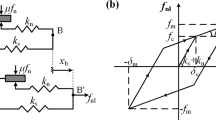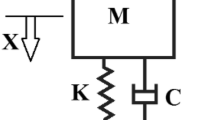Abstract
The piezoelectric accelerometer is an electronic instrument based on the direct effect of the piezoelectric material, this device is widely used in the industries to monitor and detect defects of rotating machines in an early stage. In this paper, a thorough study of the piezoelectric accelerometer is carried out to understand its design and operation principle. A mathematical model of the accelerometer is developed based on Newton motion law then a new relative sensitivity equation in function of measurement error is extracted. This new equation has allowed a significant reduction in the measurement error, a maximum improvement in the precision and an optimization of the piezoelectric accelerometer relative sensitivity by the appropriate choice of damping rate. These improvements have optimized the accelerometer parameters and performances.









Similar content being viewed by others
Abbreviations
- ω:
-
The relative frequency
- ω0 :
-
The natural frequency
- ξ:
-
The damping rate
- m:
-
The mass
- c:
-
The damping factor
- k:
-
The elasticity coefficient
- y:
-
The absolute motion
- z:
-
The relative vibratory motion
- S1 :
-
The mechanical sensitivity
- γ:
-
The acceleration
- E:
-
The measurement error
- Q:
-
The electric charge
- S:
-
The sensitivity
- C:
-
The accelerometer internal impedance
- R:
-
The insulation resistance
- S2 :
-
The electrical sensitivity
- Sr :
-
Relative sensitivity
References
Elfezazi, S. et al. (2003). Vers un outil, basé sur l’analyse fonctionnelle, pour la mise en œuvre des indicateurs de mesure de performance de la fonction maintenance. Revue française de gestion industrielle, 22(3), 1–15.
Gelders, L. et al. la gestion des pièces de rechange et la sous-traitance: quelques directives pratiques. Revue Française de gestion industrielle, 22(3), 1–10.
Molina, A. O. (2005). Méthodologie pour le placement des capteurs à base de méthodes de classification en vue du diagnostic, Doctorat de l’institut national des sciences appliquées de Toulouse.
Boulonger, A., & Pachaud, C. (1988). Diagnostic vibratoire en maintenance préventive. Paris: Dunod.
Des Forges, X. Méthodologie de surveillance en fabrication mécanique: Application de capteur intelligent à la surveillance d’une machine-outil. Thèse de Doctorat, Université Bordeaux I, Janvier 99.
Debray, K., Bogard, F., & Guo, Y.-Q. (2004). Numerical methodology to easily detect defects in revolving machines by vibration analysis. Archive of Applied Mechanics, 74, 45. https://doi.org/10.1007/bf02637208.
Dong S. –P., Yang, J., Fan, X. -W. (2017) Signal optimization of the AE piezoelectric sensor. In: 2017 Symposium on piezoelectricity, acoustic waves, and device applications (SPAWDA), Chengdu, China. https://doi.org/10.1109/spawda.2017.8340297. Accessed 27–30 Oct 2017
Hoshyarmanesh, H., & Maddahi, Y. (2017). Poling process of composite piezoelectric sensors for structural health monitoring: A pilot comparative study. IEEE Sensors Letters, 2(1), 1472–2475. https://doi.org/10.1109/lsens.2018.2806301.
Al Ahmad, M., & Ahmed, S. (2017). Heart-rate and pressure-rate determination using piezoelectric sensor from the neck. In 2017 4th IEEE international conference on engineering technologies and applied sciences (ICETAS), 29 Nov–1 Dec 2017. Salmabad, Bahrain, https://doi.org/10.1109/icetas.2017.8277911.
Booth, R., & Goldsmith, P. (2017). Detecting finger gestures with a wrist worn piezoelectric sensor array. In 2017 IEEE international conference on systems, man, and cybernetics (SMC), 5–8 Oct 2017, Banff, AB, Canada, https://doi.org/10.1109/smc.2017.8123202.
Kim, M.-K., & Yoon, S.-W. (2018). Miniature piezoelectric sensor for in-situ temperature monitoring of silicon and silicon carbide power modules operating at high temperature. IEEE Transactions on Industry Applications, 54(2), 1614–1621. https://doi.org/10.1109/tia.2017.2777923.
Mahbub, I., et al. (2015). A low-power wireless piezoelectric sensor-based respiration monitoring system realized in CMOS process. IEEE Sensors Journal, 17(6), 1858–1864. https://doi.org/10.1109/jsen.2017.2651073.
Ahmadi, S., & Azhari, S.-J. (2018). A novel fully differential second generation current conveyor and its application as a very high CMRR instrumentation amplifier. Emerging Science Journal, 2(2), 85–92. https://doi.org/10.28991/esj-2018-01131.
Omidi, A., Karami, R., Emadi, P.-S., & Moradi, H. (2017). Design of the low noise amplifier circuit in band L for improve the gain and circuit stability. Emerging Science Journal, 1(4), 192–200. https://doi.org/10.28991/ijse-01122.
Rezaee, M., Gisel, M.-N., & Saffari, S. (2017). Mathematical modeling and sensitivity analysis on cadmium transport in kaolinite under direct current electric field. Civil Engineering Journal, 3(11), 1097–1110. https://doi.org/10.28991/cej-030940.
Najafgholipour, M., & Soodbakhsh, N. (2016). Modified differential transform method for solving vibration equations of MDOF systems. Civil Engineering Journal, 2(4), 123–139.
Jahanirad, H., & Karam, H. (2017). BIST-based testing and diagnosis of LUTs in SRAM-based FPGAs. Emerging Science Journal, 1(4), 216–225.
Hu, J., Peng, H., Liu, T., Yao, X., Wu, H., & Lu, P. (2019). A flow sensing method of power spectrum based on piezoelectric effect and vortex-induced vibrations. Measurement, 131, 473–481. https://doi.org/10.1016/j.measurement.2018.08.020.
Danouj, B., Tahan, S. A., & David, E. (2013). Using a new generation of piezoelectric sensors for partial discharge detection. Measurement, 46, 660–666. https://doi.org/10.1016/j.measurement.2012.09.005.
Zhao, S., & Fu, H. (2018). A novel vibration sensor system for frequency measurement based on Bias Flip technique. Measurement, 124, 56–63. https://doi.org/10.1016/j.measurement.2018.03.070.
Noheda, B., Gonzalo, J. A., Cross, L. E., Guo, R., Park, S.-E., Cox, D. E., Shirane, G. (2000). Tetragonal-to-monoclinic phase transition in a ferroelectric perovskite: The structure of PbZr0.52Ti0.48O3. Physical Review B, 61(13), 1–18.
Acknowledgements
The authors like to thank the Algerian general direction of research (DGRSDT) for their financial support.
Author information
Authors and Affiliations
Corresponding author
Rights and permissions
About this article
Cite this article
Reguieg, S.K., Ghemari, Z., Benslimane, T. et al. Modeling and Enhancement of Piezoelectric Accelerometer Relative Sensitivity. Sens Imaging 20, 1 (2019). https://doi.org/10.1007/s11220-018-0222-y
Received:
Revised:
Published:
DOI: https://doi.org/10.1007/s11220-018-0222-y




